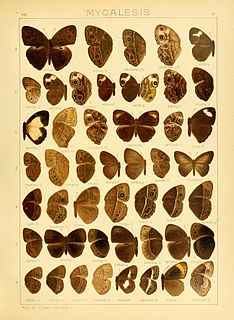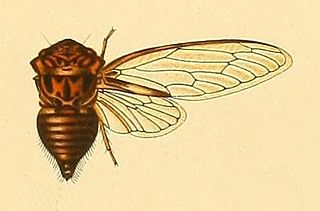| Misa | |
|---|---|
| Scientific classification | |
| Kingdom: | Animalia |
| Phylum: | Euarthropoda |
| Class: | Insecta |
| Order: | Lepidoptera |
| Superfamily: | Noctuoidea |
| Family: | Noctuidae |
| Subfamily: | Agaristinae |
| Genus: | Misa Karsch, 1895 |
| Misa | |
|---|---|
| Scientific classification | |
| Kingdom: | Animalia |
| Phylum: | Euarthropoda |
| Class: | Insecta |
| Order: | Lepidoptera |
| Superfamily: | Noctuoidea |
| Family: | Noctuidae |
| Subfamily: | Agaristinae |
| Genus: | Misa Karsch, 1895 |
Misa costistrigata is a moth in the Noctuidae family. It was described by George Thomas Bethune-Baker in 1927. It is found in Cameroon.

The skimmers or perchers and their relatives form the Libellulidae, the largest dragonfly family in the world. It is sometimes considered to contain the Corduliidae as the subfamily Corduliinae and the Macromiidae as the subfamily Macromiinae. Even if these are excluded, there still remains a family of over 1000 species. With nearly worldwide distribution, these are almost certainly the most often seen of all dragonflies.

Corinnidae is a family of araneomorph spiders, sometimes called corinnid sac spiders. The family, like other "clubionoid" families, has a confusing taxonomic history. Once it was a part of the large catch-all taxon Clubionidae, now very much smaller. The original members of the family are apparently similar only in that they have eight eyes arranged in two rows, conical anterior spinnerets that touch and are generally wandering predators that build silken retreats, or sacs, usually on plant terminals, between leaves, under bark or under rocks.
The insect family Corduliidae contains the emerald dragonflies or green-eyed skimmers. These dragonflies are usually black or dark brown with areas of metallic green or yellow, and most of them have large, emerald-green eyes. The larvae are black, hairy-looking, and usually semiaquatic. Members of this family include the baskettails, emeralds, river cruisers, sundragons, shadowdragons, and boghaunters. They are not uncommon and are found nearly worldwide, but some individual species are quite rare. Hine's emerald dragonfly, for example, is an endangered species in the United States.

Thiania is a spider genus of the Salticidae family. The genus is found in Asia from Pakistan to the Philippines, with one species found on Hawaii.

Tetragnatha is a genus of spiders containing hundreds of species. They are found all over the world, although most occur in the tropics and subtropics. They are commonly called stretch spiders, referring to their elongated body form. When disturbed they will stretch their front legs forward and the others in the other direction, thus being able to hide on blades of grass or similar elongated substrates. They are able to run over water.

Gynacantha is a genus of dragonflies in the family Aeshnidae. The females have two prominent spines under the last abdominal segment. This gives the genus name and the common name two-spined darners; they are also known as duskhawkers.

Pseudagrion is the largest genus of damselfly in the family Coenagrionidae, with over 140 species. Its range includes most of Africa, much of Asia, and Australia. Africa holds most of the diversity with almost 100 species. It has occupied most of the freshwater habitats in its range, and dominates damselfly communities in habitats as different as desert pools, equatorial rainforests and montane streams.
Ferdinand Anton Franz Karsch or Karsch-Haack was a German arachnologist, entomologist and anthropologist.

Pilodeudorix is a genus of butterflies in the family Lycaenidae. They are found in the Afrotropical realm.

The Phaneropterinae, the bush katydids or leaf katydids, are a subfamily of insects within the family Tettigoniidae. Nearly 2060 species in 85 genera throughout the world are known. They are also known as false katydids or round-headed katydids.

Dactyloceras is a genus of moths of the family Brahmaeidae.

Bicyclus is a butterfly genus from the subfamily Satyrinae in the family Nymphalidae. The species are found in the Afrotropical realm.

Sevenia, commonly called tree nymphs, is a genus of forest butterflies in the family Nymphalidae that, as larvae, feed on plants of the family Euphorbiaceae. There are fourteen species from continental Africa and two species from Madagascar. See Idea for the genus of Southeast Asian tree nymphs.

Phoneyusa is a genus of spiders belonging to the family Theraphosidae (tarantulas).

Sadaka is a genus of cicadas from West Africa.

Potamarcha is a genus of dragonfly in the family Libellulidae. Species of Potamarcha are medium sized dragonflies found in southern Asia and Australia. Potamarcha was first described by Ferdinand Karsch in 1890.
Pentathemis is a genus of dragonfly in the family Corduliidae. Pentathemis membranulata is the only known species of this genus which is found in northern Australia.

Hexophthalma is a genus of spiders in the family Sicariidae. Although the genus was originally erected in 1878, it was merged into the genus Sicarius in the 1890s, and remained unused until revived in 2017, when it was discovered that the African species then placed in Sicarius were distinct. The English name six-eyed sand spiders is used for members of the genus, particularly Hexophthalma hahni. Species in the genus have necrotic (dermonecrotic) venom, and can potentially cause serious or even life-threatening wounds.
| This Agaristinae article is a stub. You can help Wikipedia by expanding it. |